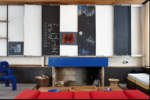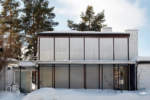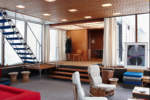Grete Prytz died on 25 September 2010, aged 93: in full activity and always with the same energy. I met her for the first time in 1994 and was literally awestruck by her beauty and intelligence: I was in company with Christian Norberg-Schulz (1926-2000) who introduced me to one of the most extraordinary persons I have ever met in my life. From that first visit, every time I have come to Oslo I have always tried to pass by Planetveien 12 (1952-55), the house in which Grete lived since 1955, the year in which Arne Korsmo (1900-1968), who apart from being her husband, was also the architect who had designed it, had moved to teach in Trondheim. Grete had spent her whole life in that house, respectful of that initial utopia which had been its programme: a place for living and working. This is what Planetveien 12 had been until the day of her death. And this is also why, even if half a century has gone by, the house has remained just the same, without aging; it has changed constantly to meet the requirements and needs of changing times, but this has never distorted its character.
When I visited her she proudly told me not only about the new projects she was involved in, but also about the new transformations undergone by the house: about the new armchairs she had put in the living room (by a famous contemporary Danish designer) as well as all the other objects that animated the scene. She also loved to repeat that the garage, useless to an old lady like her, had become the best place for her workshop for enamelling silver and metals, in which to forge prototypes that she wanted to propose for production or that she had been commissioned. Crockery for the home (she had designed Europe’s first coloured aluminium pots), but also furniture accessories in enamelled silver or glass: Hadeland Glassverk and Cathrineholm are among the leading companies for which she has worked. Daughter of Jacob Tostrup Prytz, last heir of the homonymous, more than a century old Norwegian industry of silver tableware, Grete graduated from the Academy of Applied Arts in Oslo and had specialized precisely in the crafting of silver and later of glass. Her home was full of her pieces, as well as extraordinary objects by other great designers from every period, in addition to works of art: in addition to the wall paintings by Gunnar Gudersen conceived especially or the house, works by Chagall, Mirò, Munch and so on. The house as a collection in use, as a live museum. She always said that when she would be gone, she didn’t want the house to become a museum (despite the importance and beauty of the construction of the interiors and the collections it contained). And her wish has been respected. A few months after her death, on 25 October 2010, a site with advertisements for bids offered precisely the house of Arne and Grete, as if it were just another home, among the offers of the day. The buyer must prove his or her serious intention to keep alive a dream born 56 years ago. A dream that Grete had proven able to care for with style, love and intelligence. To the very end. Once, on my return from a trip to Oslo, I wrote her a long letter telling her a lot about me and how much my meetings with her had meant to me. She smiled, and we always kept our little secret: she has been, and remains, a very special person to me.
Grete Prytz 1917/2010
area 116
| Norway









